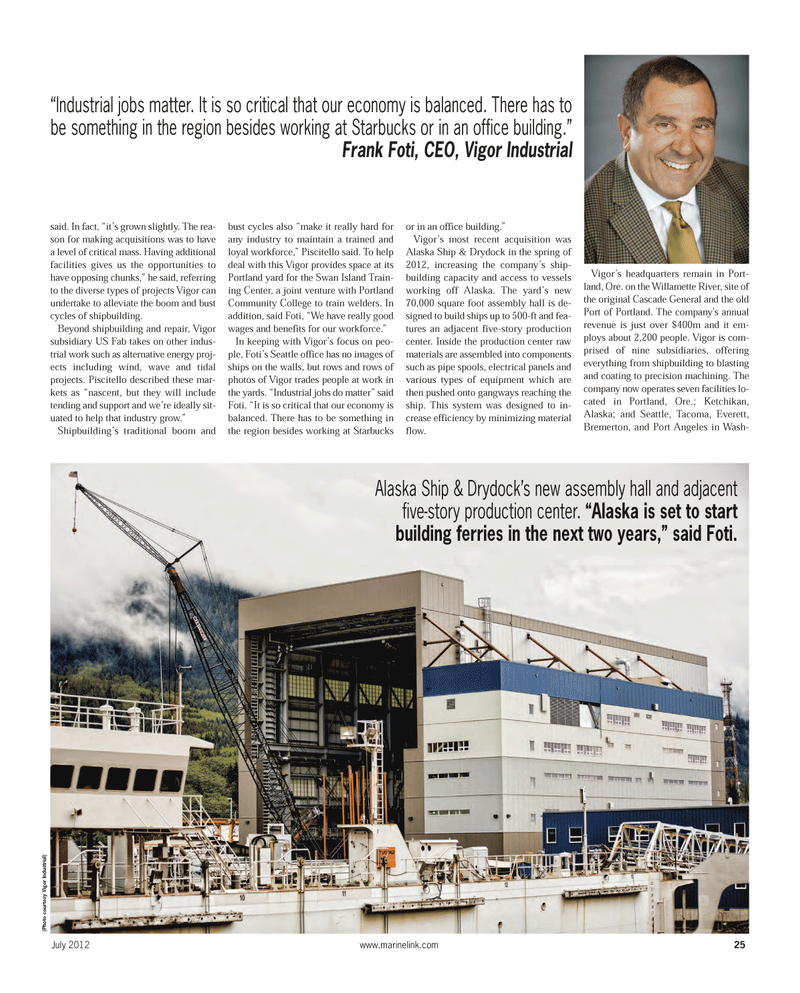
Page 25: of Maritime Reporter Magazine (July 2012)
Arctic Operations
Read this page in Pdf, Flash or Html5 edition of July 2012 Maritime Reporter Magazine
July 2012www.marinelink.com 25said. In fact, ?it?s grown slightly. The rea- son for making acquisitions was to have a level of critical mass. Having additional facilities gives us the opportunities to have opposing chunks,? he said, referring to the diverse types of projects Vigor can undertake to alleviate the boom and bust cycles of shipbuilding. Beyond shipbuilding and repair, Vigor subsidiary US Fab takes on other indus- trial work such as alternative energy proj- ects including wind, wave and tidal projects. Piscitello described these mar- kets as ?nascent, but they will include tending and support and we?re ideally sit- uated to help that industry grow.? Shipbuilding?s traditional boom and bust cycles also ?make it really hard for any industry to maintain a trained and loyal workforce,? Piscitello said. To help deal with this Vigor provides space at its Portland yard for the Swan Island Train- ing Center, a joint venture with Portland Community College to train welders. In addition, said Foti, ?We have really good wages and benefits for our workforce.? In keeping with Vigor?s focus on peo- ple, Foti?s Seattle office has no images of ships on the walls, but rows and rows of photos of Vigor trades people at work in the yards. ?Industrial jobs do matter? saidFoti. ?It is so critical that our economy is balanced. There has to be something in the region besides working at Starbucks or in an office building.? Vigor?s most recent acquisition was Alaska Ship & Drydock in the spring of2012, increasing the company?s ship- building capacity and access to vessels working off Alaska. The yard?s new 70,000 square foot assembly hall is de-signed to build ships up to 500-ft and fea- tures an adjacent five-story production center. Inside the production center raw materials are assembled into componentssuch as pipe spools, electrical panels andvarious types of equipment which are then pushed onto gangways reaching the ship. This system was designed to in- crease efficiency by minimizing material flow. Vigor?s headquarters remain in Port- land, Ore. on the Willamette River, site of the original Cascade General and the oldPort of Portland. The company's annual revenue is just over $400m and it em- ploys about 2,200 people. Vigor is com- prised of nine subsidiaries, offering everything from shipbuilding to blasting and coating to precision machining. The company now operates seven facilities lo- cated in Portland, Ore.; Ketchikan, Alaska; and Seattle, Tacoma, Everett, Bremerton, and Port Angeles in Wash- Alaska Ship & Drydock?s new assembly hall and adjacent five-story production center. ?Alaska is set to start building ferries in the next two years,? said Foti.(Photo courtesy Vigor Industrial) ?Industrial jobs matter. It is so critical that our economy is balanced. There has to be something in the region besides working at Starbucks or in an office building.? Frank Foti, CEO, Vigor Industrial MR#7 (18-25):MR Template 7/6/2012 12:04 PM Page 25

 24
24

 26
26
